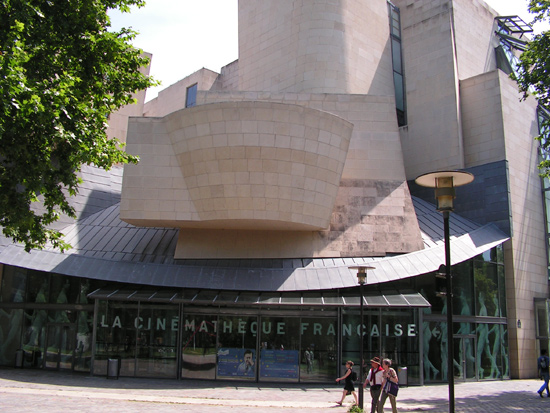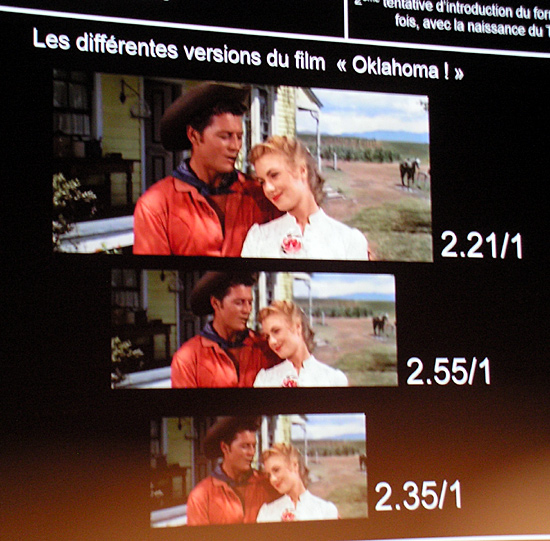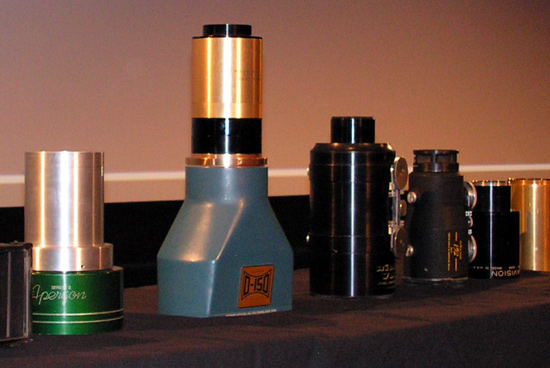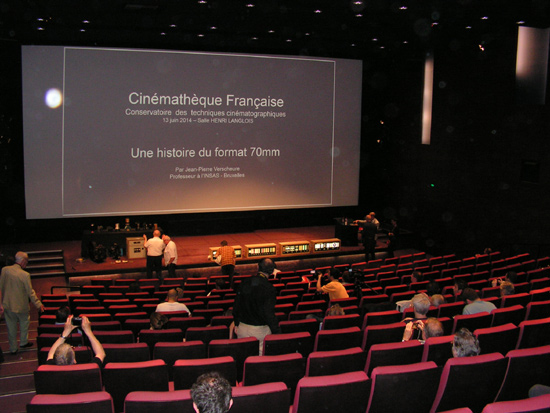70mm Retrospective in Paris |
Read more at in70mm.com The 70mm Newsletter |
| Written and photographed by: Johan C. M. Wolthuis, International 70mm Publishers | Date: 26.07.2014 |
 Frank Gehry's
building in Paris, described as "une ballerine qui soulève sa robe pour inviter les gens
à entrer" Frank Gehry's
building in Paris, described as "une ballerine qui soulève sa robe pour inviter les gens
à entrer" The Cinematheque Française, the famous Museum in Paris, ran a retrospective of significant 70mm films, from 13-30 June 2014. All original 70mm prints, complete with French subtitles. They had intended to start with Michael Todd's Around the World in 80 Days, in French entitled Tour du Monde en 80 Jours, but some days before the launch of this special retrospective, they discovered that they could not screen the print because of technical problems with the speed of the original 30 frames per second print, which their projector could not handle. Instead, the opening night featured a 70mm print of Patton - Lust for Glory, USA 1970. In the days that followed, famous films were screened, principally: 2OO1, A Space Odyssey, USA 1968, Goya, from East Germany, 1971, Anna Karénina, from the former USSR 1967, The Sound of Music, French title: La mélodie du Bonheur, USA 1965, Hello, Dolly! USA 1968, Dersu Uzala, a Russian/Japanese co-production from 1975, Lord Jim, GB 1965, Khartoum, USA 1965, concluding the season with The Master, a 70mm print from director Paul Thomas Anderson, USA 2012. |
More in 70mm reading: CINÉMA EN 70MM RETROSPECTIVE: 13 – 30 June 2014 70mm Day in Aalborg Internet link: |
 The
Retrospective, however, was launched in a most extraordinary way with a 70mm
Lecture, given on Friday afternoon in French; entitled Une Histoire du
format 70mm, (History of the 70mm Format) by Jean-Pierre Verscheure, a
Belgian professor from the INSAS Institute of Arts in Brussels. The
Retrospective, however, was launched in a most extraordinary way with a 70mm
Lecture, given on Friday afternoon in French; entitled Une Histoire du
format 70mm, (History of the 70mm Format) by Jean-Pierre Verscheure, a
Belgian professor from the INSAS Institute of Arts in Brussels. In a marathon three and a half hour power point presentation on the giant screen, he showed the international audience beautiful images of the history of widescreen in 70mm, accompanied with short clips from famous 70mm films like Oklahoma! (the CinemaScope version), My Fair Lady, Ben Hur (captured with Ultra Panavision lens), etc. There was a small exhibition, set up for the occasion on a table in front of the screen, featuring an original display of 70mm projection lenses, notably, Ultra-Panavision and Dimension 150; drawn from the personal collection of Professor Verscheure. That Friday afternoon was still within working hours; in spite of that there was a full house with nearly 400 visitors in attendance for this unique lecture. The building of the Cinematheque Française is situated at the corner of the Parc de Bercy, beside the library (Bibliothèque François Mitterand) with a lot of other attractions nearby. And when you are tired with your museum visit or a film screening you can relax in one of the cosy cafés and fine restaurants on the other side of the street. The building is open all days, except Tuesday and entrance is free!. |
|
 The
Cinematheque Française has a long and complicated history. Henri Langlois,
born in 1914 in Smyrna, Turkey was the founder of the Cinemathèque. Through
his life, Langlois collected thousands of films and film related objects,
thus creating one of the largest collections in the world, leaving a huge
heritage when he died in 1977 of a heart attack at the age of 62. Some years
earlier in 1972 he created his “dream”: Musée du Cinema, which was
completely destroyed by fire in 1980, three years after his tragic death. In
1974 he received an honorary Academy Award for his lifetime work and in 2004
French director Jacques Richard made a documentary about his life and work
as founder of the Cinematheque Française. To mark the 100th anniversary of
his birth, the Cinematheque organised a themed exhibition celebrating his
life and work . Without Henri Langlois there would not be a Cinematheque
Française, which they cheerfully admit on their website! The
Cinematheque Française has a long and complicated history. Henri Langlois,
born in 1914 in Smyrna, Turkey was the founder of the Cinemathèque. Through
his life, Langlois collected thousands of films and film related objects,
thus creating one of the largest collections in the world, leaving a huge
heritage when he died in 1977 of a heart attack at the age of 62. Some years
earlier in 1972 he created his “dream”: Musée du Cinema, which was
completely destroyed by fire in 1980, three years after his tragic death. In
1974 he received an honorary Academy Award for his lifetime work and in 2004
French director Jacques Richard made a documentary about his life and work
as founder of the Cinematheque Française. To mark the 100th anniversary of
his birth, the Cinematheque organised a themed exhibition celebrating his
life and work . Without Henri Langlois there would not be a Cinematheque
Française, which they cheerfully admit on their website!
|
|
 Salle
Henri Langlois, 412 seats and a flat screen of 13 x 6 m with curtains. The
projection throw is 28.60 m. Salle
Henri Langlois, 412 seats and a flat screen of 13 x 6 m with curtains. The
projection throw is 28.60 m.The beautiful building, which has housed the Cinematheque since 1993, is a creation of famous architect Frank Gehry, containing three cinemas, featuring amphitheatre auditoria, a library, a bookshop and a large space dedicated to film themed exhibitions on the fifth floor. The largest auditorium, Salle Henri Langlois, has 412 large seats and a flat screen of 13 x 6 m (with curtains). The projection throw is 28.60 m to screen. The booth has Kinoton projection equipment for 16mm and 35/70mm and a 4K Digital projector. The second auditorium (Salle George Franju, named after one of the co-founders of the Cinematheque) has 171 seats and a screen of 9.25 x 4.74 m. The third and smallest auditorium, the Salle Jean Epstein, has 93 seats and a screen of 6.68 x 3.17 m. The museum organises regular tours of the building. |
|
 François
Carrin and Laurent Verscheure and his father Jean-Pierre in the background François
Carrin and Laurent Verscheure and his father Jean-Pierre in the backgroundFrank Gehry, the Californian architect grew to fame through his design of the Guggenheim Museum in Bilbao, Spain, and in Dubai, as well as his Disney Concert Hall in Los Angeles. He described his building in Paris, according to the website, as "une ballerine qui soulève sa robe pour inviter les gens à entrer", translated as “a ballerina who lifts up her dress to invite people to enter the building”! Maybe he had in mind the famous scene with Marilyn Monroe standing on the street, as her dress is lifted by the air coming up from an underground grating. Gehry’s conception of the building, was of a split façade in different dimensions, pointing to the sky. |
|
| Go: back - top - back issues - news index Updated 22-01-25 |
